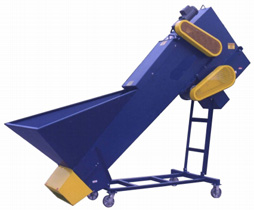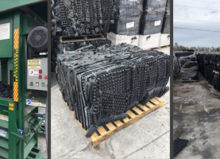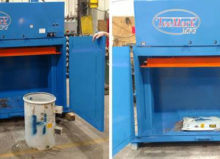What is a Glass Bottle Crusher?
 Glass bottle crushers and glass container crushers are used to crush beer, wine, liquor, soda, and laboratory testing glass bottles and containers. Crushing the glass bottles and containers reduces the volume of waste glass resulting in lower disposal fees.
Glass bottle crushers and glass container crushers are used to crush beer, wine, liquor, soda, and laboratory testing glass bottles and containers. Crushing the glass bottles and containers reduces the volume of waste glass resulting in lower disposal fees.
Glass bottle crushers and glass container crushers are used to crush:
- Glass beer bottles
- Glass wine bottles
- Glass liquor bottles
- Soda and Soft Drink bottles
- Glass laboratory testing bottles and containers.
Crushing glass bottles and containers reduces the volume of waste glass which results in lower disposal fees
Frequently asked Questions
Who would benefit from a Glass Bottle and Container Crusher?
• Bars
• Pubs
• Restaurants
• Cafeterias
• Nightclubs
• Laboratories
• Beverage Distributors
• Breweries
• Bottlers
• Recycling Operations
• Recycling Centers
• Hotels
• Cruise Ships
• Clubs
• Casinos
• Municipalities
• Universities
• Pharmaceuticals Companies
• Testing Facilities
What are the benefits of a glass crusher?
• Reduces glass disposal costs
• Frees up space otherwise used to store empty bottles
• Cullet can be reprocessed into new bottles
• Glass can be recycled endlessly with no loss in quality or purity.
• Glass recycling produces no additional waste like some other products do during the recycling process.
• Cash refunds are offered for most glass containers. Check with your state for refund availability. At least 11 different U.S. states offer refunds.
How much does a glass crusher cost?
• From $2,200 to $100,000 and up.
What material can you crush?
• Beer Bottles
• Wine Bottles
• Soda Bottles
• Juice Bottles and Containers
• Liquor bottles.
• Pharmaceuticals, and Laboratory testing bottles, containers, ampules, flasks, tubes, and vials.
What size glass can you produce?
• Variable glass cullet
How much footprint does a Glass Bottle Crusher need?
Depends on the model:
• Model 95 External Dimensions: 25 ½” (e/stand 61”) Height x 24 5/8” Width x 48” Deep BDS External Dimensions: 38” Tall x 20” Wide 22” Deep
• GB Series External Dimensions: 10’ Height x 11’ 8” Length x 59” Width
• GB/BC External Dimensions: 10’ 4” Height x 15’ 5” Length x 5’ 1” Width
• Model GBS External Dimensions: 72” Height x 64” Length x 34” Width
• Model 150 External Dimensions: 79 1/2” Tall x 50” Wide 34” Deep
• Model 160 External Dimensions: 13’ 3” Long x 5’ Wide x 8’ 9 ¼” Height
• Model 250 External Dimensions: 57” Tall x 38” Wide 44 3/4” Deep
• Model 318 External Dimensions: 87 1/2” Tall x 38” Wide 60” Deep
• Model 620 External Dimensions: 8’ 6” Tall x 45” Wide 12’ 8” Length
How much does a Glass Bottle Crusher weigh?
Depends on the model:
• Model 95 – 135 lbs.
• BDS – 147 lbs.
• GB Series – 1,370 lbs.
• GB/BC – 2,500 lbs.
• Model GBS – 275 lbs.
• Model 150 – 650 lbs.
• Model 160 – 1,670 lbs.
• Model 250 – 1,700 lbs.
• Model 318 – 470 lbs.
• Model 620 – 1,188 lbs.
How does a glass crusher ship?
• LTL Truck on a skid or pallet. LTL carriers are the most cost-effective choice.
How do you unload it from the truck?
• A fork-lift is the most used machine for unloading the vertical baler from the shipping truck. The lifting equipment must be designed for lifting the weight of the crusher.
How does a glass crusher work?
Depending on the model:
• BDS: It is simply a piece of machinery that crushes or breaks down glass bottles, reducing the area needed to store empty containers and minimizing the volume for disposal purposes. When the ON/OFF switch is on, a motor will run causing the crusher bar to spin rapidly. Glass bottles are introduced into the machine through the bottle chute. When they come in contact with the crusher bar, they are reduced to small pieces of glass called cullet. The cullet falls down the drum and into the bucket in the bottom enclosure of the machine.
• For the machine to function normally:
• The bucket must be in place and seated fully in the unit
• The door must be closed
• The covers must be in place
• The crusher bar must be spinning at top speed (allow a minimum of 3 seconds before inserting a bottle)
• Model GB: Glass bottles are loaded into the conveyor hopper. The primary function of the in-feed conveyor is to meter the materials into the crushing mechanism. Glass bottles drop into the crushing mechanism where a cleated drum rotating at high speed crushes the glass against an adjustable steel pressure plate, breaking the material. From the crushing mechanism, the material is discharged into your waiting container. The cullet size can be made larger or smaller by changing the clearance between the breaker plate and the drum.
• Model GB/BC: Glass bottles are loaded into the conveyor hopper. The primary function of the in-feed conveyor is to meter the bottles into the crushing mechanism. Glass bottles drop into the crushing mechanism where a cleated drum rotating at high speed crushes the glass against an adjustable steel pressure plate, breaking the material. From the crushing mechanism, the material is discharged into a container lift with primary screen system which contains most of the glass, and a temporary capture tank with secondary screen and drain. The cullet size can be made larger or smaller by changing the clearance between the breaker plate and the drum. When the primary screening chamber is full (approximately 1 cu. yd. of glass) the glass breaker is rolled back on the caster tracks by the operator and the screening chamber rotates and discharges the glass cullet into your container, conveyor, etc. for recycling.
• Model GBS: Glass bottles are loaded into the chute and are then dropped into the crushing mechanism. Glass bottles drop into the crushing mechanism where a cleated drum rotating at high speed crushes the glass against an adjustable steel pressure plate, breaking the material. From the crushing mechanism the material is discharged into your waiting container. The cullet size can be made larger or smaller by changing the clearance between the breaker plate and the drum.
• Model 95: Is available is 3 different formats to meet your glass crushing needs. The model 95-2 is our standard unit with 2 impellers to crush glass. The 95-4 and 95-6 have 4 and 6 impellers respectively to crush the glass to finer residues. Each works the same with good results, the only difference is the grade of the residue.
• Model 150, 160 or 170: High output can, and glass crushers designed for long life and trouble-free operation. They are all capable of handling full or empty bottles, as well as aluminum, bi-metal, or steel cans. The model 150 is a stand-alone unit with a gravity feed hopper. The 160 and 170 models include a conveyor to allow the crusher to fed with steady flow of material and for ease of loading. The 170 model has a magnetic head and a hinged door on the conveyor to allow the user to sort aluminum from steel or bi-metal cans. Each machine is designed to provide years of dependable service and a minimum of 80% in size reduction.
• Model 250, 270: High volume can and glass crusher. Designed for stand alone or in conjunction with conveyors. User friendly, easy to maintain, and require no change in machine set-up to crush cans or glass.
• Model 318: Medium to high volume glass crusher. Designed for stand-alone use or in conjunction with a conveyor, it also can be mounted below chutes in MRF applications.
• Model 620: High volume glass crusher, capable of handling full or empty bottles. The conveyor is designed with side flanges on the belt and cover rails to contained material and extend the life of the belt.
Electrical options for the glass breaker
• BDS: 120-volt single phase, 60 Hz, 9′ grounded cord included. A dedicated 15-amp circuit is recommended. Power requirements – 9.0 amps.
• GB: 240/480-volt, three phases.
• GB/BC: 240/480-volt, three phases.
• GBS: 220-volt, single phase.
• Model 95: 115/230-volt, single phase, 60 Hz.
• Model 150: 230/460-volt, three phase, 60 Hz.
• Model 160: 220-volt, three phases, 60Hz.
• Model 250: 230/460-volt, three phase, 60 Hz.
• Model 318: 115/230-volt, single phase, 60 Hz.
• Model 620: 220-volt, single phase, or 208/230/460-volt, three phase, 60 Hz.
Lube/Grease:
• Only use high quality universal grease. Do not over grease.
• Lubricate electrical motors annually.
• Apply Jet Lube white knight anti-seize or similar anti-seize product to all adjustment bolts to prevent galling when tightening.
Safety system may include:
• GB: Electrical components are UL listed
o NEMA-3R (outdoor) enclosure
o Manual start switches with thermal overload protection
o Individual motor overload/short circuit protection
o Safety interlock on crusher access door
• GB/BC: Electrical components are UL listed
o NEMA-3R (outdoor) enclosure
o NEMA 4 electrical enclosure
o Manual start switches with thermal overload protection
o Individual motor overload/short circuit protection
o Safety interlock on crusher access door
o GBS: Electrical components are UL listed
o NEMA-3R (outdoor) enclosure
o Manual start switches with thermal overload/short circuit protection
Preventative Maintenance:
• GB: For maximum life and performance, the machine should be maintained regularly.
(Caution: All maintenance should be done with the power disconnected and the machine locked out/tagged out!)
o Lockout/tag out power and rinse the entire machine with water at the end of every 8
o hour shift. (This helps slow the corrosive effects of acids on steel and paint.)
o Grease all bearings. (Refer to instruction page for bearings and motors.)
o Check conveyor belt tension and tracking daily (see page 5). Conveyor belts should be cleaned of all foreign material on a need-to basis. Debris on the underside of the belt will cause premature wear on both the conveyor belt and the head and tail pulleys.
o Check drive chain tension on the conveyor drive motor(s) and the belt tension on the crusher
o drive motor, initially after one week, then monthly.
o Check all nuts and bolts that may have become loose during operation.
o Check all electrical connections and tighten, as necessary.
o Check set screws on all bearings when greasing.
• GB/BC: For maximum life and performance, the machine should be maintained regularly.
(Caution: All maintenance should be done with the power disconnected and the machine locked out/tagged out!)
o Lockout/tag out power and rinse the entire machine with water at the end of every 8
o hour shift. This helps slow the corrosive effects of acids on steel and paint.
o Grease all bearings. (Refer to instruction page for bearings and motors.)
o Check conveyor belt tension and tracking daily (see page 6). Conveyor belts should be
o cleaned of all foreign material on a need-to basis. Debris on the underside of the belt will
o cause premature wear on both the conveyor belt and the head and tail pulleys.
o Check drive chain tension on the conveyor drive motor(s) and the belt tension on the crusher
o drive motor, initially after one week, then monthly.
o Check all nuts and bolts that may have become loose during operation.
o Check all electrical connections and tighten, as necessary.
o Check set screws on all bearings when greasing.
o Check hydraulic fluid monthly with the HDL in the down position by removing the filler vent
o cap and maintain fluid at 1” below the tank opening.
o Grease bearings once a month (one pump only) or as deemed necessary by Qualified
o Maintenance Personnel.
o Periodically remove clevis pins, check for wear; should the pin fit loose call the factory.
o Remove debris build-up from under and around machine.
o Visually inspect for structural integrity (i.e., cracked welds, dented metal parts, etc.).
• GBS: For maximum life and performance, the machine should be maintained regularly.
(Caution: All maintenance should be done with the power disconnected and the machine locked out/tagged out!)
o Lockout/tag out power and rinse the entire machine with water at the end of every 8-hour shift. This helps slow the corrosive effects of acids on steel and paint.
o Grease all bearings. (Refer to instruction page for bearings and motors.)
o Check all nuts and bolts that may have become loose during operation.
o Check all electrical connections and tighten, as necessary.
o Check set screws on all bearings when greasing.
Available options for the glass crushers:
• GB: 110, 240-volt single phase GB-1 only
208, 380, 415, or 575-volt, three phases
Custom conveyors, hoppers, and discharge heights
As a mechanism for a platform, stand, or hopper, Stainless Steel Options,
• GB/BC: 110, 220-volt single phase GB-1 only
208, 380, 415, or 575-volt, three phases
Custom conveyors, hoppers, and discharge heights
As a mechanism for a platform, stand, or hopper, Stainless Steel Options
• GBS: 220-volt, single phase
208, 240, 380, 415, 480, or 575-volt, three phases
Larger capacity units modeled after REM GB-1 or GB-2 crusher units
• Model 95: Stand
Explosion proof, NEMA 7, Class 1, Division 1, Stainless Steel Options
• Model 150, 160, 170: Chimney Hopper for #10 Cans (Model 151)
Explosion proof, NEMA 7, Class 1, Division 1, Stainless Steel options
• Model 250, 270: Explosion proof, NEMA 7, Class 1, Division 1, Stainless Steel Options, Casters, Blower for aluminum and bimetal cans, Stainless Steel Options
• Model 318: Casters
75 lbs./cu. ft. standard crushed particle size (smaller or larger particle size available upon request), Stainless Steel Options
REM® GB Series glass breakers
REM®s GB Series Glass Breakers are complete crushing systems. Rugged, unitized construction produces a machine that will withstand years of punishing use in recycling operations. The GB series requires minimal maintenance and has a reputation in the recycling industry as a crusher built to last.
DURABLE DESIGN
The GB series is a highly efficient machine incorporating many standard features that are only offered as options by other manufacturers. To operate, simply load the glass containers into the low in-feed hopper and the conveyor automatically feeds the crusher. The rotating steel crushing drum and breaker-plate design produces a uniform cullet size acceptable to the recycling industry. Features such as the self-cleaning tail-pulley and enclosed conveyor belt make the GB a durable and low maintenance machine.
HIGH PRODUCTIVITY
With a capacity of up to 12,000 pounds per hour, the GB series will help you maximize shipping weights while being economical to operate. REM®s makes the GB series affordable and dependable to improve your bottom line.
REM® GB/BC Full beverage glass breaker. Process “line-rejects” or “out-dated product” and recover recyclable glass with the REM® GB/BC Full Beverage Glass Breaker. To operate, simply load the glass containers into the Glass Breaker hopper. The rotating steel crushing drum and breaker plate design produce a uniform cullet size acceptable to the recycling industry. The broken glass is discharged into a screening chamber where the liquid is separated into a capture tank with drain. When the screening chamber is full (one cubic yard of glass) the operator rolls the Glass Breaker back and the screening chamber rotates and discharges the glass cullet into your container for recycling.
REM® GBS Compact Glass Breaker
REM® GBS is the ideal hand-fed glass breaker for small recycling and business applications. Built tough for years of economical operation using the same time-proven design of REM®s large Glass Breakers units. The GBS series requires minimal maintenance with a reputation in the recycling industry as a “glass crusher built to last.”
DURABLE DESIGN REM® GBS series is a highly efficient machine incorporating many standard features that are only options of other manufacturers. To operate, simply feed glass containers into the chute opening that feeds the crusher unit. The rotating steel crushing drum and breaker-plate design produces a uniform cullet size acceptable to the recycling industry.
GLASS CRUSHER Model 95-2
Delivers Size Reduction of 80% in Volume
Save time, money, labor, and space with this new improved crusher from PRODEVA. We have made our popular, original design even better with more features. Machine is ideal for bottlers, recycling centers, cafeterias, restaurants, taverns, municipalities, and institutions. Users like the big savings and convenience in removal and handling costs. Like all Prodeva products our Model 95-2 is made for hard use, trouble-free operation, and dependability for years in service.
• Rated capacity of over 600 glass bottles per hour.
• Crushes up to and including 1-gallon size glass jugs or bottles.
• Lightweight; easily moves from one drum to another. Fits over 30 and 55-gallon drums.
• Special hardened steel impellers give maximum resistance to wear.
• Machine crushes efficiently as fast as operator can feed it.
• Factory-direct parts and service.
GLASS CRUSHER Model 318
A medium to high volume glass crusher. Designed for stand-alone use, in conjunction with a conveyor, or can be mounted below chutes in MRF applications. A small compact unit that will hold up to most anything you can throw at it. Backed by over 35 years of experience in the size reduction and recycling industry.
• Rated capacity: 2 to 3 tons per hour
• Crushes up to and including one-gallon bottles
• Processes full or partially filled containers
• Factory-direct parts and service
CAN AND GLASS CRUSHER Model 150
Reduces Size Volume by 80%
A proven Prodeva performer in our line for over 30 years in customer use. Unit is ideal for any institution, restaurant, hospital, hotel, university and public or private recycling operations. In fact, almost anywhere glass containers and beverage cans are a disposal, storage, or conversion concern. Model 150 is user-friendly; easy to maintain and is highly portable with optional castors available. Customers report it is trouble-free and withstands hard use. Built to Prodeva time-honored quality standards … added assurance you are getting equipment that will handle the toughest jobs.
• Rated capacities of Model 150:
o Up to 10,000 12 oz. cans per hour.
o Up to 25 1-gallon cans per minute.
o Over 2 tons- of glass per hour.
• Despite high-output crushes thoroughly and efficiently either cans or glass.
• Safety engineered throughout.
• Large, crushing chamber eliminate feed problems, assures high volume output.
• Factory-direct parts and service.
CAN AND GLASS CRUSHER Model 250
A proven Prodeva performer in our line since 1958. Unit is ideal for can manufacturers, recycling centers, bottlers, and breweries. In fact, anywhere glass containers, beverage cans or food containers are a problem. Model 250 is user friendly; easy to maintain and requires no change in machine set-up to crush cans or glass. Built for hard use and trouble-free operation with minimal maintenance or up-keep. Backed by Prodeva’s proven experience in manufacturing quality size-reduction equipment.
• Rated capacities of Model 250:
o 2000 lbs. of Aluminum cans per hour
o 4000 lbs. of Steel cans per hour
o 4 ton of Glass per hour
• Safety engineered throughout
• Factory direct parts and service.
• Overload compression springs to prevent jamming.
• Model 250 will crush cans and glass up to and including 5 gallons.
CAN AND GLASS CRUSHER Model 270
A proven Prodeva performer in our line since 1958. Unit is ideal for can manufacturers, recycling centers, bottlers, and breweries. In fact, anywhere glass containers, beverage cans or food containers are a problem. Model 270 is user friendly; easy to maintain and requires no change in machine set-up to crush cans or glass. Built for hard use and trouble-free operation with minimal maintenance or up-keep. Backed by Prodeva’s proven experience in manufacturing quality size-reduction equipment.
• Rated capacities of Model 270:
o 2500 lbs. of Aluminum cans per hour
o 5000 lbs. of Steel cans per hour
o 5 ton of Glass per hour
• Safety engineered throughout.
• Factory direct parts and service.
• Overload compression springs to prevent jamming.
• Model 270 will crush cans and glass up to and including 5 gallons.
GLASS CRUSHER Model 620
A high-volume glass crusher designed for long life and trouble-free operation. This model is capable of handling full or empty bottles. Conveyor designed with side flanges on belt and cover rails to contain material. This feature has proven to greatly extend the life of the belt, eliminating some costly routine maintenance found on other crushers.
• Rated capacity: 3 to 4 tons per hour
• Crushes up to and including one-gallon containers
• Processes full or partially filled containers
• Factory-direct parts and service
Specifications Model 620
• Machine constructed of heavy gauge steel
• Designed for easy maintenance and upkeep
• Replaceable crushing chamber
• Reduces volume by 80%
• 1/2 HP crusher motor
• 1/2 HP conveyor motor
• Crushed glass weight = 80 lbs./cu. ft.
• 16″ wide conveyor bed
• Features self-cleaning tail pulley
• Replaceable rubber discharge shroud
• Hardened replaceable crusher bar
• Side flange belt
COMBINATION CAN GLASS CRUSHER Model 160
Delivers Size Reduction of 80% in Volume
• Rated Capacities of Model 160:
o Up to 10,000 cans per hour.
o Up to 3 tons of glass per hour.
• Crushes cans flat and converts glass into ideal cullet density
• Processes full or partially filled containers
• Handles containers as large as 1-gallon capacity
• Factory-direct parts and service



